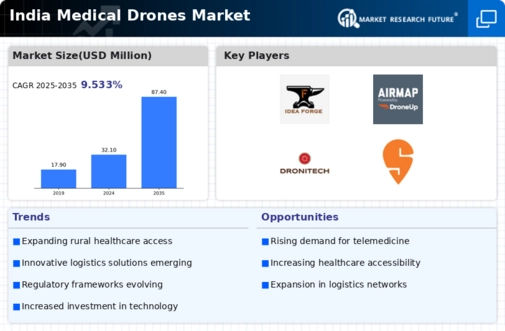Government Initiatives and Funding
The Indian government is actively promoting the medical drones market through various initiatives and funding programs aimed at enhancing healthcare delivery systems. Recent policy frameworks have been established to support the integration of drone technology in medical logistics. For example, the government has allocated approximately $10 million to pilot projects that utilize drones for transporting medical supplies in underserved regions. Such initiatives not only provide financial backing but also create a conducive regulatory environment for the medical drones market to flourish. As these government efforts gain momentum, they are expected to catalyze further investments and innovations in drone technology, ultimately benefiting public health.
Cost-Effectiveness of Drone Deliveries
Cost considerations are becoming increasingly relevant in the medical drones market in India. The use of drones for medical deliveries can significantly reduce transportation costs compared to traditional methods, especially in hard-to-reach areas. For instance, the operational costs associated with drone deliveries can be up to 50% lower than those of conventional vehicles when factoring in fuel, maintenance, and labor. This cost-effectiveness is particularly appealing to healthcare providers and government agencies looking to optimize their logistics. As the medical drones market continues to evolve, the financial benefits of drone technology are likely to attract more stakeholders, thereby accelerating adoption rates and expanding service coverage across the country.
Rising Demand for Healthcare Accessibility
The medical drones market in India is experiencing a notable surge in demand driven by the need for enhanced healthcare accessibility. With a significant portion of the population residing in remote areas, traditional healthcare delivery methods often fall short. Drones offer a viable solution by facilitating the rapid transport of medical supplies, vaccines, and essential medications. According to recent estimates, the market is projected to grow at a CAGR of approximately 25% over the next five years. This growth is indicative of the increasing recognition of drones as a critical component in bridging healthcare gaps, particularly in rural regions. The medical drones market is thus positioned to play a pivotal role in ensuring timely medical interventions, ultimately improving health outcomes across diverse demographics.
Technological Innovations in Drone Capabilities
Technological advancements are playing a crucial role in shaping the medical drones market in India. Innovations such as improved battery life, enhanced payload capacities, and advanced navigation systems are making drones more reliable and efficient for medical deliveries. For instance, the latest drone models can carry payloads of up to 5 kg over distances exceeding 100 km, which significantly expands their operational range. These advancements not only enhance the functionality of drones but also increase their appeal to healthcare providers. As the medical drones market continues to innovate, it is likely to attract more investments and partnerships, further driving growth and adoption in the healthcare sector.
Growing Awareness of Emergency Response Capabilities
The medical drones market in India is increasingly recognized for its potential in emergency response scenarios. Drones can deliver critical medical supplies, such as blood and organs, within minutes, which is crucial during emergencies. Recent studies indicate that drone deliveries can reduce response times by up to 70%, thereby saving lives in critical situations. This growing awareness among healthcare providers and emergency services is likely to drive demand for drone technology. The medical drones market is thus positioned to become an integral part of emergency response strategies, enhancing the overall efficiency and effectiveness of healthcare delivery in urgent situations.















Leave a Comment